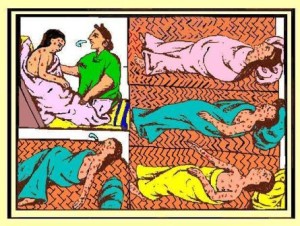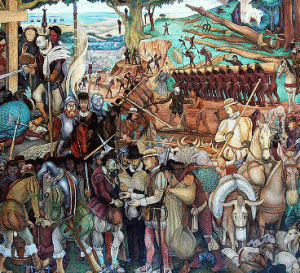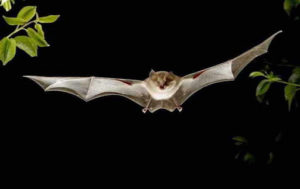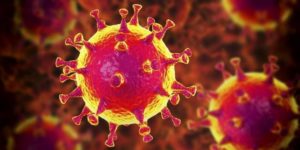Overpopulation: mechanism at negative retroaction 3/4
The latter example explains what happens when a population comes into contact with a new virus and the system or predator-prey, parasite – host sets haven’t yet developed homeostasis.
Before getting to balance, mortality may be very high, so that, if a population that had already been in contact with the virus, is present in the ecosystem, the species that comes into contact with it, for the fitst time, may completely disappear.
This what happened to some species of birds in New Zeland: within one hundred years some species disappeared and, for this reason there was someone who, like Myers, suggested they might have contracted some diseases from the foreign birds imported [1].
Evidently the native species were greatly susceptible to pathogenic germs housed by the foreign birds: the result was the destruction of the first ones. The birds, coming from afar, had learnt for long to live with the microorganisms they were hosts of: for this reason they weren’t damaged by the zoonoses that destroyed the communities of local birds.
So here is another evident example, that is, how a microparasite (bacterium or virus) may be particularly virulent and lethal for species it has never come into contact with.
We have seen to happen the same to Amerinds when they came into contact with the viruses imported by the Spaniards.
Native Incas and Atzechi didn’t completely disappear, but they decidetly diminished numerically before entering a dynamic balance with the new viruses imported by the “Conquistadores”.
Genetic Inferiority, in the mechanism at negative retroaction, can be specific towards a particular limiting factor (predation, competition, virus) or generic.
A lot of predators, for example, attack, above all, those animals that, anyway, would starve, because unable to get food,or would die of a disease. Among 15 sparrows, a sparrow-hawk can recognize the one blind in one eye and 15 out of 17 homing pigeons, preyed by a peregrin, should be somehow ill [3].
At this point we can enunciate a law: the final result of the factors limiting population is a product that doesn’t change by changing the single factors. If one of the limiting factors is reduced or eliminated the product doesn’t change because the other factors increase automatically.
When man alters natural balance and eliminates, artificially, one of the above mentioned factors of regulation, inevitably, the active factors left replace the others, and since their absolute value increases, the final product doesn’t change: a given number of creatures, of a certain species, present in a certain territory.
In parks or artificial reserves, predation, famine and competition don’t act as factors limiting the number of mammals any longer, but in these cases it’s often the fourth factor, a disease, to operate with the same final effectiveness we should have if the other three were acting, too.
Recently, in the Tanzanian park of Serengeti, the 30% of a population of 3,000 lions was exterminated by a virus like distemper. The same happened, owing to an unknown virus, in a reserve of bears in Nothern Italy.
[1] Meyers J G The present position od the endemic birds in New Zeland. J Sc and Tech 6:65-99.1923
[2] Lack D. Predation on birds. in The natural regulation of animal numbers, pgg.157. Oxford at Clarendon Press. 1954.
[2] Those women who take care of street cats are called like that in Rome.
[3] In the movie Nosferatu, starring Klaus Kinski, there is a very nice scene where just the black mouse plays a leading role; a ship, with a coffin containing the corpseof a Vampire (Not Expired/Nosferatu), docks, slowly and mysteriously since it is without a crew, at the port of a town in the North. A multitude of black mice swarms along the ropes into the town and spreads plague.
[4] Pollitzer R, Meyers K F, The Ecology of Plague. In Studies in Disease Ecology. Pgg. 445-8 . Edited by May J M Hafner Publishing Company Inc. New York 1961.
Translate from “Il Virus Intelligente” by Enrica Narducci
To be continued in
4°) Mechanism at negative retoaction or genetic feedback 4/4
See also :
1°)Mechanism at negative retroaction or genetic feedback 1/4
2°)Mechanism at negative retroaction or genetic feedback 2/4
About the Author
Written by Ferdinando Gargiulo
Ferdinando Gargiulo offers you a new perspective on why new viral epidemics, assaults, infanticides, suicide epidemics and even environmental catastrophes. Always engaged in his research decides to create a blog to offer his readers content of high value.
Search
Recent Post
Follow on Facebook
Find us on Google Plus
Follow on Twitter
Stories Archive
- Blog (132)
- child labor (10)
- child Prostitution (6)
- Climate Change (20)
- depression (53)
- Depression and suicide (51)
- Environmental catastrophes (22)
- epidemics (44)
- Genetic hypothesis of suicide (47)
- HIV (24)
- Leonardo Da Vinci (8)
- overpopulation (108)
- pedophilia (7)
- Serial Killer (33)
- Suicide Genes (46)
- suicides (56)
- The child as a product (10)
- the intelligent virus (106)
- Uncategorized (59,869)
- Unexplained aggression (36)
- You Tube (6)












